QuestionQUESTION: Hi
i went to petsmart, and they said my watert chemistry is fine. i looked at medications while i was there, and they only had Tetracycline. it said it is an antibactiral, and its expensive, so i am looking for other soulutions befor i buy it. i also tried a pea, but as i said, he is not eating, and the pea sunk, so he barley noticed it. some soulutions i saw online was epsome salts. will that work? dose it need to be in a seperate container or can it be added to the tank directly? i have aquarium salt as well. will this work? if not, can i add the recomended amount for freshwater aquarims anyways or will it not work with my gourami? If i need to, i can buy the Tetracycline, but i dont know if it is the type you ment, because it did not say anything about consipation or digestion, only about other sores and finrot.
Thanks
mike
ANSWER: Hi Mike,
I have heard of epsom salts baths for treating constipation, but it is my opinion, and this is only my opinion, they do not work. You cannot put epsom salts in your tank. This will make your water too alkaline, and will do more harm than good in the long run. Aquarium salt should never be used when a fish is constipated. Espom salt baths stress fish, and then you may be stuck with another disease. I do not recommend this method, and would advise Tetracycline. Tetracycline is an antibiotic that cures many diseases, and many have had success with curing Swim Bladder which is due to constipation. "Kanamycin" is very good, but difficult to find. Antibiotics are all expensive, but you have no choice but to cure the little guy. You can find tetracyline in forms of pills or powder. You must remove your carbon when treating your fish. Furan-2 is a little less expensive if you can find it. The colouration that comes with Tetracycline, will disappear with a water changes, and new carbon, once your fish is cured. Have you tried Walmart? Sometimes they do have these medications, but it is made by another company. They are all very good medication, and come under the same name. Tetracycline is tetracyline whatever the name of the company that makes it. If your gourami was eating, I would try daphnia..but since he refuses to eat, you cannot wait. Constipation quickly leads to Swim Bladder Disease, and then Dropsy to which there is no cure. It is almost impossible to cure a fish with Dropsy.
The main cause to constipation is overfeeding, and poor diet. When the little guy is well, feed him twice a day in small amounts...example 2 pellets, or 2 flakes for one meal. Vary his food, and feed him one pea a week so he can clean out his system. On the day you feed him the pea, feed him nothing else. A good quality flake is a must, along with other types of food. The more you vary, the healthier he will be. Fish that are well fed, and kept in clean water free of ammonia, and nitrites hardly ever get sick. In the long run, it is better to invest in good quality food, than to cure with antibiotics, or other medication. We must always remember that little gouramis have little tummies about the size of their eye, so it is important not to overfeed them.
Lynda
---------- FOLLOW-UP ----------
QUESTION: Hi,
Sorry to keep bothering you, but i am very concerned for freddy (i named him now :]) today his scales are slightly sticking out giving the pincone look. i called a fish store, and they said this could be from swelling from the constipation. i just gave him and epsome salt bath out of desperation, but nothing happened. i also herd about metronytrozal. His poking out sccales have me worried about dropsy, because it looks similar to the pics of it i see online, although it is not as severe as some. i realy want my fish to live. could dropsey have developed this quickly? or is it just swelling? what is the best course of action now?
AnswerHello,
Swim Bladder Disease leads to dropsy very quickly. Dropsy is the hardest internal bacterial infecttion to cure. It can be cured, but you must act very fast. Penicillin, Tetracycline and Naladixic Acid have been known to help cure dropsy. If you see that the little fish is suffering, I hate to tell you this but maybe it would be best to euthanize him if you see that he is suffering.
I have copied this off the web because it would have been too long for me to write, but this is what you should do if you are going to have to put him to sleep. I hope not, but just in case...
Buy Clove oil
Clove oil (eugenol) is available at any drug store and is sold as a toothache remedy. It has been used for years as a fish anesthetic for surgeries and tagging procedures. Clove oil will put a fish to sleep and ensure it feels no pain. However the fish can wake up from this sleep if removed from the clove bath. The last step of adding the vodka will ensure the fish expires.
Here are the steps for fish up to 3" (7.6cm) in length:
1. Add tank water to a measuring cup or mixing bowl. Measure the amount of tank water you add to the cup or bowl and make a note of it. Place the fish in the container. If the fish is in a clear cup place a dark towel around the cup to calm the fish.
2. Fill a small, clean jar or bottle with tank water, leaving some room at the top. This might be a baby food jar or pill bottle. Put 1 drop of clove oil in the jar or bottle, cap and shake vigorously. The clove oil must emulsify, turning the water milky white.
Gently pour about 1/4 of this emulsified mixture into the fish's container. The fish will begin listing as it starts to fall asleep. Let the fish be for about 10 minutes. The fish should be resting on the bottom by then. It will look dead, but if you watch closely its gills will be breathing once every few seconds. If after 10 minutes the fish is still rising off the bottom swimming intermittently, retrieve the jar or bottle of emulsified clove oil, re-shake, and add the same dose to the fish's container. Wait again.
3. Once the fish is asleep on the bottom, add 20-25% white grain alcohol. For example, if the fish is in 8oz (240ml) of water, add 2oz (60ml) of vodka. Let the fish stay there for at least 20 minutes.
4. Check the fish carefully after 20 minutes for any gill movement. If there is no gill movement over a 60 second period, the fish has expired.
For large fish: Place the fish in a bucket or plastic tub with tank water. Again, measure how much tank water is used. The dose for the mixture in the jar will be 10 drops of clove oil per gallon (3.78 liters). For example, if the fish is placed in 3 gallons (11 liters) of tank water, fill your jar with tank water and add 10 x 3 = 30 drops of clove oil. After shaking the jar vigorously, slowly add the entire mixture to the bucket or tub that contains the fish. Gently mix it in. Once the fish is asleep, follow the previous instructions for adding 20-25% vodka.
To eliminate vodka from the procedure and overdose with clove oil alone: Put the fish to sleep first as stated above, waiting 10 minutes for the fish to settle on the bottom. A lethal overdose of clove oil is 50 drops per gallon (3.78 liters), or 5x stronger than the initial dose that anesthetizes the fish. Using the same example, if the fish is in 3 gallons (11 liters) of tank water, the jar's lethal mixture will include 50 x 3 = 150 drops of clove oil. Administer it the same way, by first emulsifying (shaking) the jar before adding the mixture to the fish's container.
Once you've added the entire mixture to the fish's container, wait a few hours. Finally, make sure there is absolutely no gill movement by watching the gills closely for at least 60 straight seconds. If you see any gill movement, add more emulsified clove oil.
Using clove oil alone is not recommended because even though a fish looks dead it can recover once it has been removed from the bath. Clove oil is a preferred anesthetic precisely because it is hard to overdose a fish with clove oil. Therefore be especially diligent when using clove oil alone that the fish is really dead. It is much safer to use vodka as the final step.
Unacceptable methods of euthanasia are: freezing, boiling, chopping, removing the fish from water, using a seltzer tablet, slamming, pithing, decapitating, or flushing down the toilet. These methods are slow, torturous, stressful or violent. Clove oil followed by vodka is both inexpensive and humane. The fish goes to sleep like we might before an operation, and simply doesn't wake up.
Hopefully you will rarely have to perform this task, but when you do, it's at least comforting to know your fish does not have to suffer.
I hope you save your little friend, and won't have to put him to sleep, but if you do, this is the most humane way of doing it.
Lynda

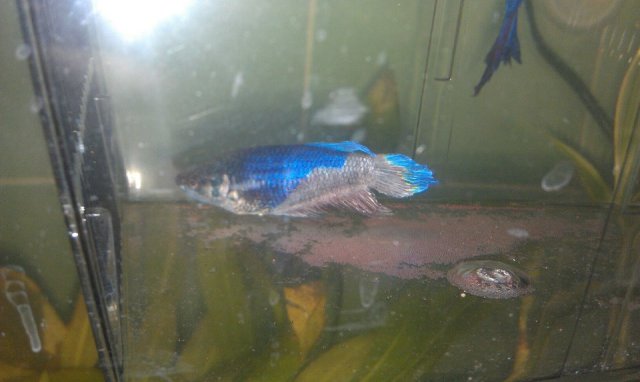 Identify disease?
Question
Betta Disease?
So, I wrote this whole t
Identify disease?
Question
Betta Disease?
So, I wrote this whole t
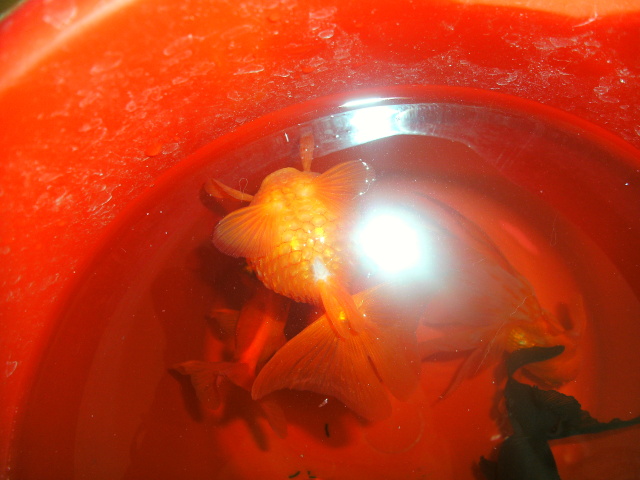 My Goldfish looks in pain.. :-(
Question
poorly fish..
I have just gone to clear my gol
My Goldfish looks in pain.. :-(
Question
poorly fish..
I have just gone to clear my gol
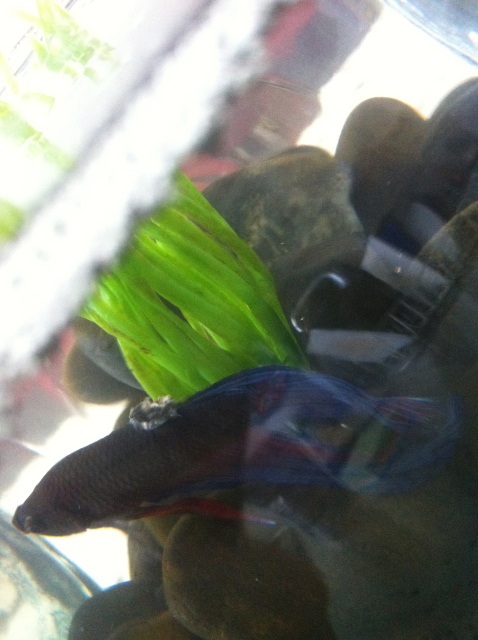 Siamese fighting fish has weird white growth
Question
white growth
Siamese fighting fish has
Siamese fighting fish has weird white growth
Question
white growth
Siamese fighting fish has
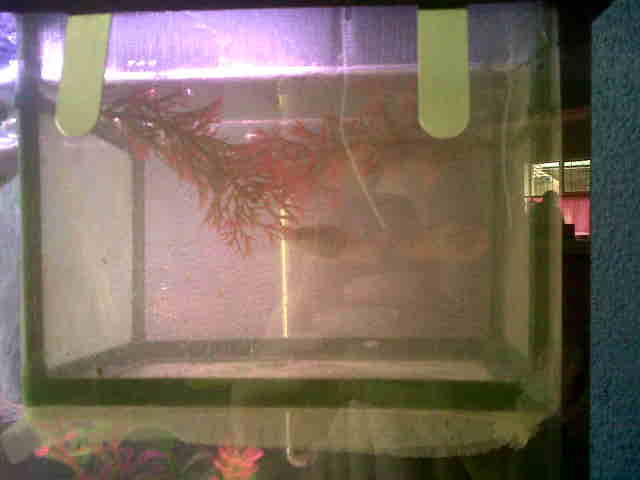 are my mollie about to drop fry?
QuestionQUESTION: Hello all, hope youre doing good ;-)m
are my mollie about to drop fry?
QuestionQUESTION: Hello all, hope youre doing good ;-)m
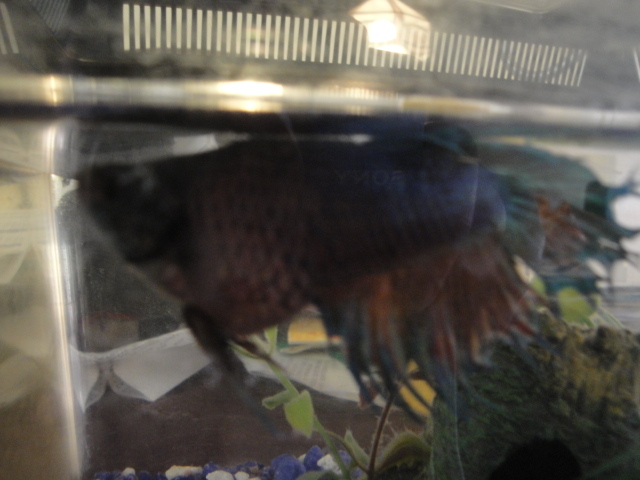 Fish to human infection
Question
Bloated Betta
Im taking care of my friends fis
Fish to human infection
Question
Bloated Betta
Im taking care of my friends fis